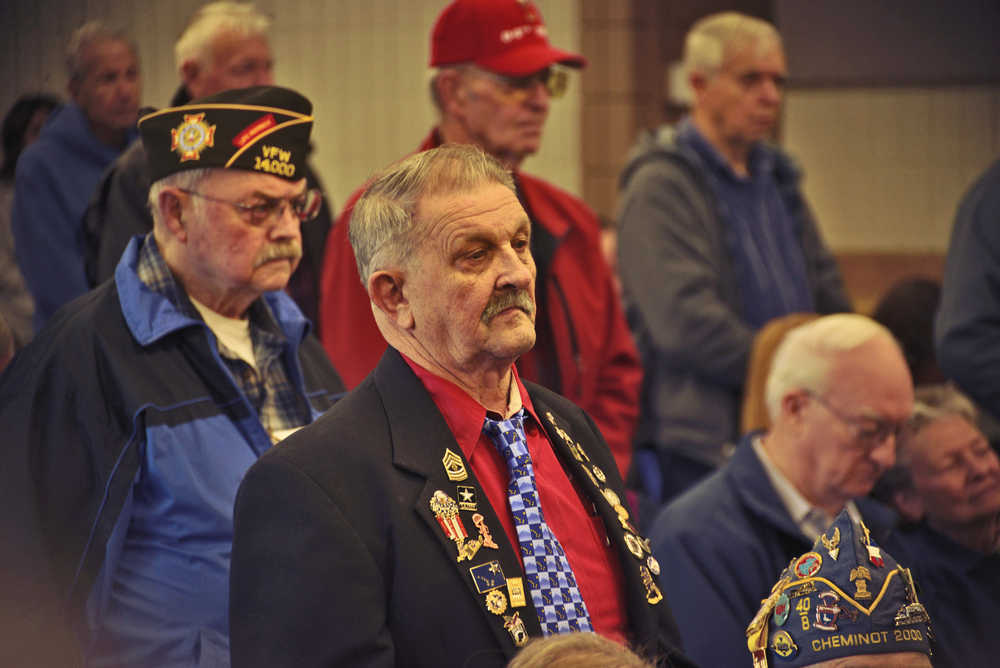Speaking at Friday’s Veterans Day ceremony, Colonel James “Doc” Halliday asked his audience to recognize veterans not only with words of thanks, but by listening.
“Thank a veteran for their service today, but also ask about their story,” Halliday said. “The oral history of these ordinary Americans who were called to do extraordinary things is disappearing more and more every year. Our World War II vets are disappearing, then Korea, and onward. Ask their story.”
Summarizing his own story, Halliday— an Alaska Army National Guard State Dental Surgeon — jokingly described himself as “a dental school drop-out,” due to the fact that he left his classes for a year to be deployed in Operation Desert Storm. He’s since provided dental services in Bosnia and Afghanistan, as well as missions in Mongolia and humanitarian work in Surinam. Others at Friday’s ceremony at the Soldotna Regional Sports Complex also brought with them wide-ranging experience — from Bill Field, wounded by grenade shrapnel in the World War II Battle of Okinawa, to Greg Fite, a member of the first Alaskan unit to be deployed to Iraq, and National Guard Officer Marty Hall, who served in Alaska during the late Cold War era.
For many at the ceremony, military service is a part of family history. Fite’s great uncle fought in World War II, and his father was a veteran as well. Fite himself joined the Alaska National Guard in 1983 and in 2005 was sent to Baghdad.
Asked what Baghdad was like in 2005, Fite replied, “You been to the dump here?”
“It was like being at the dump on our hottest day,” Fite said. “It would be like 120 degrees during the daytime. As Alaskans we didn’t like the heat too much … I actually got to work a night shift, so it wasn’t so bad. We were patrolling, we did perimeter security. We were at one of Saddam’s old palaces, so we had security around the outside of that palace … Mostly it was in Humvees, but sometimes (on foot).”
Retired National Guard Cavalry Scout Officer Marty Hall also did security patrols, though in a very different environment. Hall joined the Guard in 1978 and said his unit was “part of the defense of Alaska, and the defense of the pipeline.” Their primary mission, he said, included patrolling the Trans-Alaska Pipeline corridor in M113 armored troop vehicles.
“Some exciting times and interesting times in the ‘80s,” Hall said. “… At times the Cold War was a hot war in the state of Alaska. I’m always cracking up when Sarah Palin said she can see Russia from her doorstep, because in many ways it was kind of true.”
Bill Field’s war was an unambiguously hot one. Field, a Nikiski homesteader, commercial fisherman, retired school bus driver and retired carpenter, arrived to work at Pearl Harbor about two months after the Japanese bombing and subsequently fought in the World War II Pacific Theatre.
“I was working over there (in Hawaii) and I got drafted in 1943, and I went into the service in 1944,” Field said. “… I was in only two and a half years, but I managed to get into two battles. Saipan and Okinawa.”
Field was wounded — for which he received a Purple Heart — during the last week of the 82-day invasion of the island of Okinawa.
“It was actually during the mop-up I got wounded,” he said. “Hand grenade shrapnel. If you get that close, you know you’re getting close enough.”
Field said he fought under Lieutenant General Simon Bolivar Buckner Jr., who was killed in Okinawa by a mortar shell, making him among the highest-ranking officers to die in World War II.
Field’s friend Ty Handley, a veteran of the Alaska Air National Guard who had been deployed to Korea among other places, was impressed by Field’s reminiscence of Buckner.
“In six years, I saw one general,” said Handley.
Field saw a contrast between World War II and present conflicts against terrorist groups, saying that in World War II “we knew who we were fighting.” The war’s impact on the civilians of his time was also very different, he said.
“They had rationing, a lack of a lot of stuff,” Field said. “It made them conscious of the war, and everybody put in everything they could during World War II. There was so many soldiers, so many people went in, that every family had some one in the service.”
Hall said he knew of five World War II veterans at Friday’s ceremony.
According to Hall, the VFW post’s annual Veteran’s Day ceremony used to be held in Kenai’s Leif Hansen Memorial Park but was moved indoors several years ago to accommodate aging attendees — most of whom remained in the room as the ceremony’s color guard gave a rifle salute in the parking lot outside, though the building’s windows were opened for them to hear.
As the color guard returned to the building after firing their salute, two older veterans shared a moment of banter in the hallway.
“That rifle feel heavier than it used to?” one color guard member asked another.
“Weighs about the same,” the other replied.

